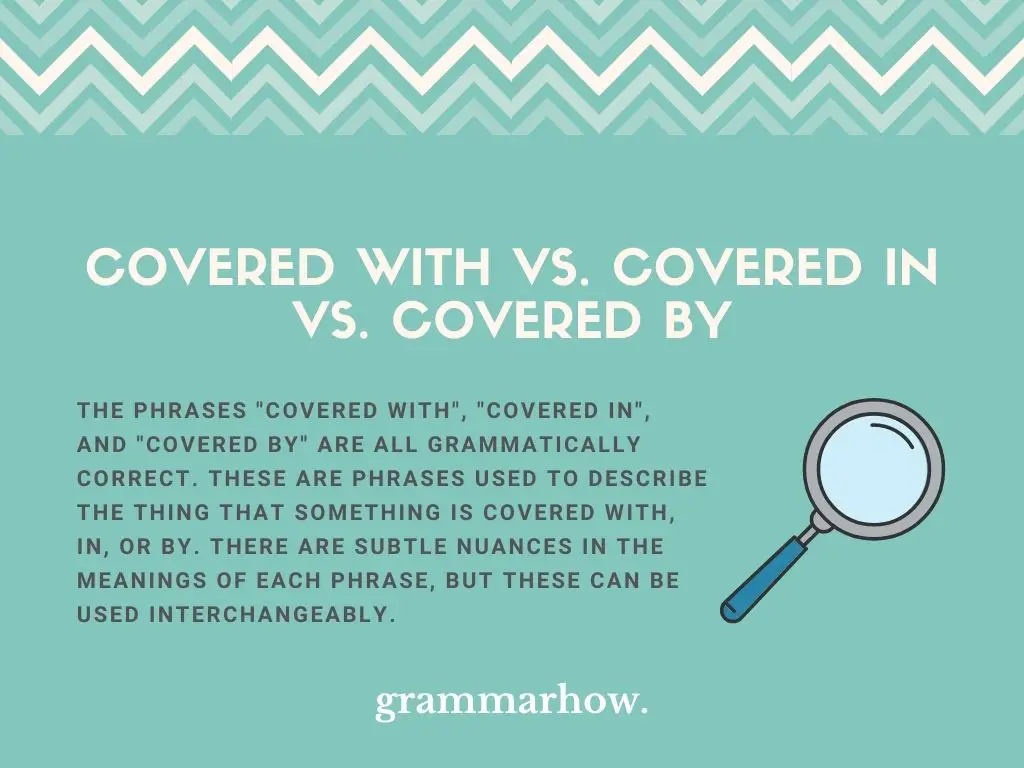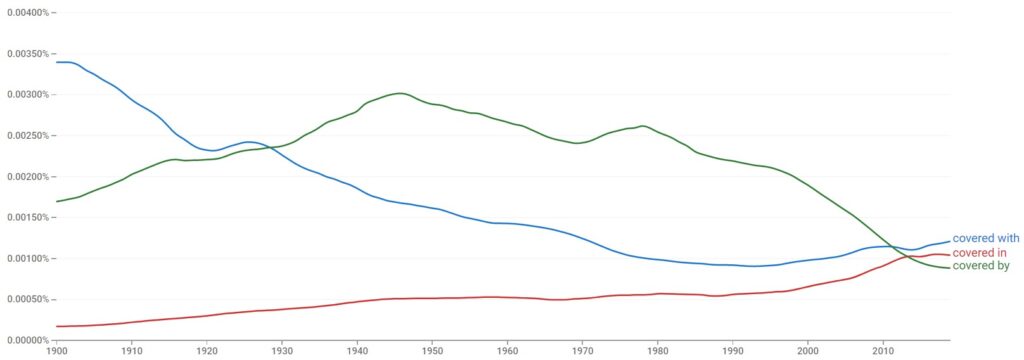There are many prepositions in the English language, and it takes practice to know when to use the right preposition. In this article, we’ll be discussing the prepositions that go with the word “covered”, such as “with”, “in”, and “by”.
Covered With vs. Covered In vs. Covered By
The phrases “covered with”, “covered in”, and “covered by” are all grammatically correct. These are phrases used to describe the thing that something is covered with, in, or by. There are subtle nuances in the meanings of each phrase, but these can be used interchangeably.

The word “covered” can be used with the prepositions “with”, “in”, and “by” to make the phrases “covered with”, “covered in”, and “covered by”.
You use these phrases when you want to describe something that is covered by another. There are cases in which these phrases can be used interchangeably, such as in the following sentences:
- Her car was covered with dead leaves.
- Her car was covered in dead leaves.
- Her car was covered by dead leaves.
All of the above sentences share the same meaning: that dead leaves covered her car.
However, there are subtle differences between the phrases, due to the differences in the prepositions used. The phrases “covered with” and “covered in”, for example, better suit sentences such as:
- My aunt served a chicken covered with gravy.
- My aunt served a chicken covered in gravy.
Meanwhile, using “covered by” in the same sentence sounds a bit strange and does not quite work:
- Incorrect: My aunt served a chicken covered by gravy.
On the other hand, there are instances in which “covered by” is the more appropriate phrase to use, such as in the following sentence:
- Is the damage to the car covered by your insurance?
Using the other two phrases for the same sentence is wrong:
- Incorrect: Is the damage to the car covered with your insurance?
- Incorrect: Is the damage to the car covered in your insurance?
Covered With
“Covered with” is a grammatically correct phrase. It is used to describe something that is covered with another thing.
The word “with” is a preposition that can be used with the verb “covered”. You use these words together when you want to describe something being covered with another thing.
The phrase can be used interchangeably with “covered in” and “covered by”, however, this is not true in every instance.
Below are examples of how to use “covered with” in a sentence:
- Every wrong answer on the game show results in the contestant being covered with slime.
- I couldn’t find the gate to her house because it was covered with vines.
- Sandra’s mother couldn’t find her daughter because she was covered with pillows and blankets.
- My aunt made spaghetti covered with cheese.
- It was really hot at the beach yesterday, but we didn’t get sunburnt because we were covered with sunblock.
Covered In
When you want to describe something covered in another thing, you can use the phrase “covered in”.
“In” is a preposition that means “inside of”. The preposition can be used with the word “covered” to make the phrase “covered in”.
This phrase is used when you want to describe something covered in another thing. It can be used interchangeably with the phrases “covered with” and “covered by”.
Using “covered in”, however, is more often used in sentences involving physical coverage, like substances.
Below are examples of how to use “covered in” in a sentence:
- I like my bananas covered in cheese.
- The steak was covered in sauce.
- Hannah returned from the forest covered in blood.
- The princess was unrecognizable when she was covered in mud.
- I didn’t recognize her face because she was covered in makeup.
Covered By
“Covered by” is a grammatically correct phrase that you can use to describe something that covers another thing, whether physically or metaphorically.
You can use the phrase “covered by” when you want to describe something that covers another thing. It can be used interchangeably with the phrases “covered in” and “covered with” in some cases.
However, what sets “covered by” apart from the other two is the fact that it can be used to describe something covered in a metaphorical manner, in the sense that it will be “taken care of”.
Below are examples of how to use “covered by” in sentences involving physical coverage:
- The bridge was covered by fog so we couldn’t really see where we were going.
- He could usually see her through the window, but today his view was covered by a curtain.
- Her face was covered by her hair so she wouldn’t be recognized by her enemies.
- Her car was covered by a tarpaulin so it wouldn’t get dirty.
Below are examples of how to use “covered by” in sentences involving metaphorical coverage:
- The materials for the experiment are covered by my research grant.
- My expenses were covered by my aunt.
- His son’s accident was covered by insurance.
- My hospital bills were covered by my healthcare plan.
Which Is Used the Most?
According to Google Ngram Viewer, “covered with” is more commonly used than both “covered in” and “covered by”.
Google Ngram Viewer shows us how frequently certain words and phrases are used in a wide range of books.

Based on data from books written in English published from 1900 to 2019, we can see that “covered with” is currently the most frequently used among the three phrases. “Covered in” is currently the second most commonly used, while “covered by” is currently the least used of the three.
Interestingly, it was not always so. “Covered with” was most popular from 1900 to 1928, but was surpassed by “covered by” until about 2010. “Covered in” was the least used of the three from 1900 until about 2010, when it surpassed “covered by”.
Final Thoughts
You can use the phrases “covered with”, “covered in”, and “covered by” to describe something that covers another thing. These are often used interchangeably. There are, however, subtle nuances in the meanings of each phrase. There are also cases in which they are not interchangeable.
